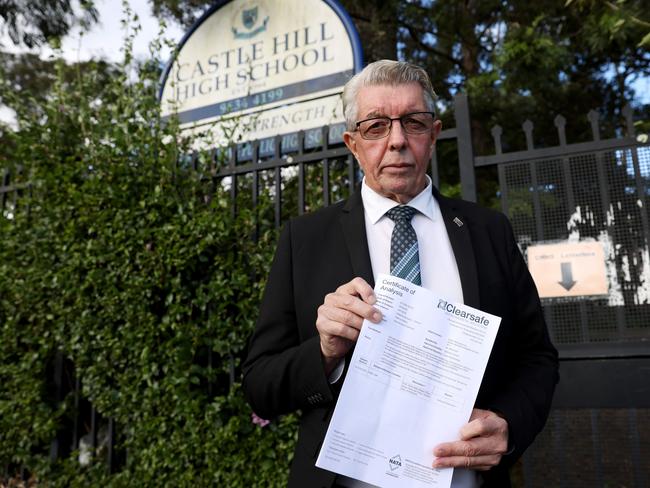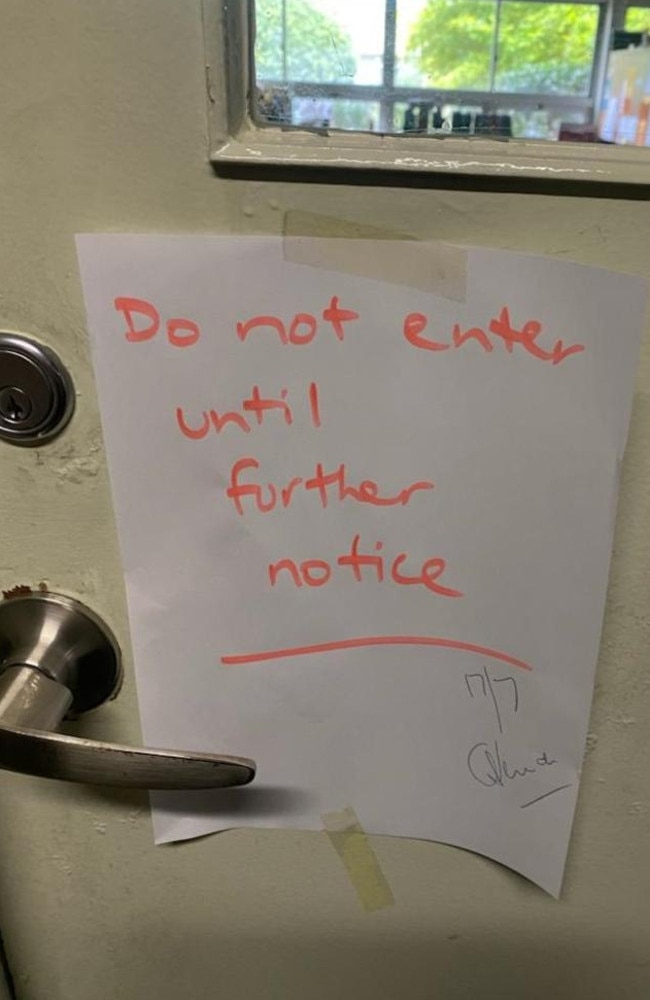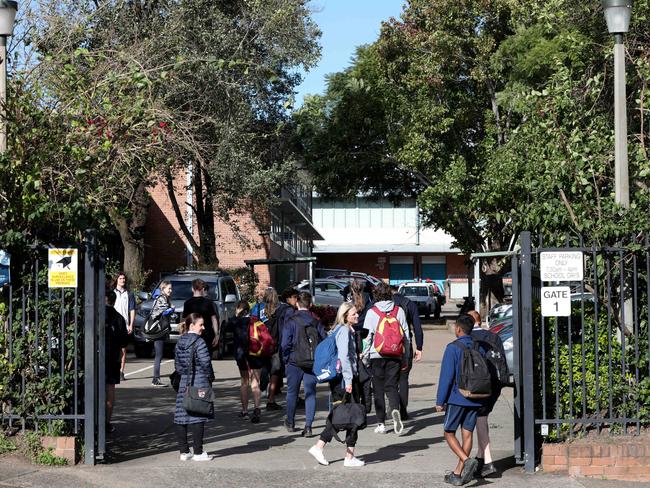SafeWork NSW prosecutes Education Department over Castle Hill High School asbestos scandal
A mysterious notice on a school staffroom door has ended in criminal charges against the education department in a long-running Sydney scandal.
EXCLUSIVE
An asbestos scandal at one of New South Wales’ largest high schools has resulted in charges being laid against the state’s education department.
Staff reported breathing in dust falling from the ceilings for years at Castle Hill High School in Sydney’s northwest, even after a sample had come back positive for the deadly material.
Regulator SafeWork NSW confirmed that it had filed charges against the NSW Education Department on Thursday over alleged breaches of the Work Health and Safety Act.
“They relate to alleged failures by the Department to discharge its health and safety duties to workers and other persons between April 2015 and October 2018 regarding asbestos issues at Castle Hill High School,” a spokesman told news.com.au.
The Education Department confirmed the court proceedings in a message to parents on Friday.
“The health, safety, and wellbeing of students and staff are our highest priorities,” an Education Department spokesman told news.com.au.
“We have cooperated fully with SafeWork NSW throughout its investigations and will continue to do so. We will also continue to consult independent experts and relevant regulators on the best course of action when managing and remediating asbestos in schools.”

The asbestos scandal, first revealed by news.com.au in 2022, related to a positive test result from material taken from a social science staffroom in 2016, which staff allege they were told had come back “all clear”.
Four years later, the Education Department announced “previously unknown asbestos” had been found in the roof cavity at the school during a “proactive inspection”.
Multiple teachers then complained to the Education Department saying they had raised concerns years earlier, sparking an internal investigation by the Professional and Ethical Standards (PES) Directorate.
During that investigation the 2016 certificate of analysis was discovered, confirming the presence of both Chrysotile, white asbestos, and Amosite, brown asbestos — considered one of the most hazardous types.
Although the report referred to asbestos, it did not say whether the material posed an exposure risk.
“People were sweeping up dust from that staffroom, the library and other staffrooms and taking it to the [school] asking for it to be tested for years,” one teacher told news.com.au at the time.
“That sounds absurd and it is. People were just like, ‘When are they going to test this fricking dust? More of it fell on us today.’”
A note place on a staffroom door after one incident simply read, “Do not enter until further notice.”

After the 2016 test, multiple staff members logged requests in the school’s internal issue tracking system demanding to see a copy of the results but “nobody was ever shown the test”, the teacher said.
In an entry dated August 16, 2018, one woman wrote, “I would like to see the report regarding the testing of the particles falling from the ceiling. I haven’t seen the report. The particles continue to fall over [the] last four years and I continue to breathe them in. There are a number of staffrooms with this complaint. I am sitting at my desk breathing in these fine particles every day.”
The issue was marked as “closed” by the school’s WHS officer on December 6, 2018.
Principal Georgie Fleming told staff in an April 2022 email that the Education Department had “recently been made aware” of the document.
Ms Fleming was not with the school when the tests were conducted in 2016.
Amid concerns thousands of students and teachers had been exposed to the dust over the years, SafeWork NSW launched an investigation into who knew what when and the circumstances surrounding the test, to determine whether the school breached asbestos management policies.

The revelations sparked outrage from parents and led to a state parliamentary inquiry, which heard in September 2022 that while the long-term exposure risk at the school was considered to be low, “errors of judgment” had been made by senior school staff members and the proper procedures were not followed.
“Unfortunately, in this case, the school did not contact the asset management unit when it should have and the AMU’s help and expertise was not immediately enlisted,” School Infrastructure NSW chief executive Anthony Manning told the inquiry, The Sydney Morning Herald reported.
Parent Elizabeth Madders told the inquiry the community had been left in the dark and met with a “wall of silence” on the saga. “We’ve lost all faith in the school, the Department of Education and school infrastructure,” she said.
“Parents have been asked to accept the unacceptable. Parents send their children to school and think, ‘Is today the day they will breathe in deadly asbestos into their lungs?’”
The Education Department said on Friday it was “supporting its students, their families and staff during this period with important information and with practical support and counselling services as necessary”.
“The school will work with families who have students needing support,” it said.
“The health, safety, and wellbeing of students and staff at Castle Hill High School are the highest priorities for the Department of Education. Castle Hill High School is safe for all students and staff to learn and work. The department has engaged occupational hygienists to check the school facilities and appropriate clearance certificates have been received to ensure the site is safe.”
It comes as NSW grapples with widespread asbestos contamination of garden mulch in Sydney, with more than 70 garden beds and parks currently being tested and at least 25 sites already confirmed to contain the deadly material.
More Coverage
Originally published as SafeWork NSW prosecutes Education Department over Castle Hill High School asbestos scandal





